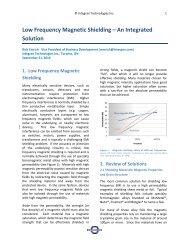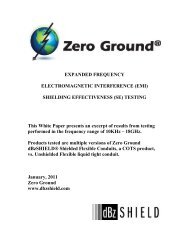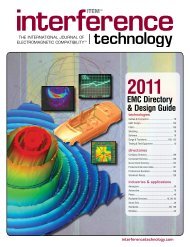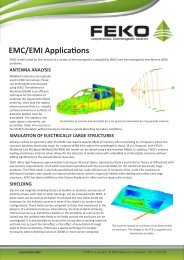Simple Method for Predicting a Cable Shielding Factor, Based on ...
Simple Method for Predicting a Cable Shielding Factor, Based on ...
Simple Method for Predicting a Cable Shielding Factor, Based on ...
Create successful ePaper yourself
Turn your PDF publications into a flip-book with our unique Google optimized e-Paper software.
S impl e Me t h o d f o r Predic t ing a c a bl e Shi e l ding Fa c t o r / M a rdigui a n<br />
shielding<br />
amplifier, antennas, shielded/ anechoic room (or<br />
stirred mode reverberating chamber) etc ...<br />
• It carries the typical uncertainties of radiated<br />
measurements ( mean value <str<strong>on</strong>g>for</str<strong>on</strong>g> ordinary radiated<br />
EMI test uncertainty being 6dB)<br />
• It is very sensitive to the tested cable set-up: height<br />
above ground, terminati<strong>on</strong> loads and type of excitati<strong>on</strong><br />
in near field c<strong>on</strong>diti<strong>on</strong>s. For instance, a<br />
transmit antenna at 1m from the test sample will<br />
create near field c<strong>on</strong>diti<strong>on</strong>s <str<strong>on</strong>g>for</str<strong>on</strong>g> all frequencies below<br />
50MHz. If the antenna is of the dipole family,<br />
the near-field will be predominantly Electrical, i.e.<br />
a high-impedance field and the SE results will look<br />
excellent. If the transmit antenna is a magnetic<br />
loop, the field will be a low-impedance H field, and<br />
the SE results will be much less impressive.<br />
b) Transfer Impedance (Zt), in c<strong>on</strong>trast to SE, is a<br />
purely c<strong>on</strong>ducted measurement method, with accurate<br />
results, typically within 10% (1dB) uncertainty. But Zt, being<br />
in Ohm/meter has a dimensi<strong>on</strong> and cannot be directly<br />
figured as a shield per<str<strong>on</strong>g>for</str<strong>on</strong>g>mance .<br />
c) Shield Reducti<strong>on</strong> <str<strong>on</strong>g>Factor</str<strong>on</strong>g>, Kr rec<strong>on</strong>ciles the two<br />
methods, by using the best of Zt - the benefit of a c<strong>on</strong>ducted<br />
measurement, and of SE : the commodity of a<br />
direct figure in dB.<br />
Definiti<strong>on</strong> of the Shield Reducti<strong>on</strong> <str<strong>on</strong>g>Factor</str<strong>on</strong>g><br />
We can define Shield Reducti<strong>on</strong> factor (Kr) as the ratio<br />
of the Differential Mode Voltage (Vd) appearing, core-to<br />
shield at the receiving end of the cable, to the Comm<strong>on</strong><br />
Mode Voltage (Vcm) applied in series into the loop (Figure<br />
1).<br />
Kr (dB) = 20 log (Vd / Vcm) (1)<br />
This figure could also be regarded as the Mode C<strong>on</strong>versi<strong>on</strong><br />
Ratio between the external circuit (the loop) and the<br />
internal <strong>on</strong>e ( the core-to-shield line).<br />
Slightly different versi<strong>on</strong>s of this definiti<strong>on</strong> are sometimes<br />
used like:<br />
Kr (dB) = 20 Log (Vd 2<br />
/ Vd 1<br />
)<br />
Where,<br />
Vd 1<br />
: differential voltage at the receive end when the<br />
shield is not there (disc<strong>on</strong>nected)<br />
Vd 2<br />
: differential voltage at the receive end with the<br />
shield normally grounded, both ends.<br />
This latter definiti<strong>on</strong> would be more rigorous, somewhat<br />
reminiscent of the Inserti<strong>on</strong> Loss used in EMC<br />
terminology, i.e. it compares what <strong>on</strong>e would get without<br />
and with the shield, <str<strong>on</strong>g>for</str<strong>on</strong>g> a same excitati<strong>on</strong> voltage ( see<br />
Fig. 1, B). This eliminates the c<strong>on</strong>tributi<strong>on</strong> of the core<br />
wire resistance and self-inductance, since they influence<br />
identically Vd 1<br />
and Vd 2<br />
.<br />
Calculated Values of Kr <str<strong>on</strong>g>for</str<strong>on</strong>g> simple<br />
cases, <str<strong>on</strong>g>for</str<strong>on</strong>g> length ι < λ/2<br />
Let express Vd, using the classical Zt model, assuming<br />
that the near end of the cable is shorted (core -to-shield) :<br />
Vd = Zt x l x I shield<br />
where l : length of the shielded cable<br />
Expressing the shield current, I shield<br />
:<br />
I shield<br />
= Vcm / Z loop<br />
We can replace Vd by its value in the expressi<strong>on</strong> of Kr:<br />
Kr = Zt.l / Z loop<br />
Z loop<br />
itself is a length-dependent term, since it is simply<br />
the impedance of the shield-to-ground loop, which <str<strong>on</strong>g>for</str<strong>on</strong>g> any<br />
decent shield is a lesser value than that of the core wire<br />
plus the terminal impedances.<br />
Z loop<br />
(Ω) = ( R sh<br />
+ jω. L ext<br />
) . l<br />
where,<br />
R sh<br />
= shield resistance<br />
L ext<br />
= self-inductance of the shield-toground<br />
loop<br />
Replacing Z loop<br />
by its expressi<strong>on</strong>:<br />
Zt (Fig. 2) c<strong>on</strong>sists in shield resistance R sh<br />
and shield<br />
transfer (or leakage) inductance Lt.<br />
Thus, we reach an expressi<strong>on</strong> <str<strong>on</strong>g>for</str<strong>on</strong>g> Kr as a dimensi<strong>on</strong>less<br />
number, independent of the cable length:<br />
This expressi<strong>on</strong> is interesting in that it reveals three<br />
basic frequency domains:<br />
a) <str<strong>on</strong>g>for</str<strong>on</strong>g> Very Low Freq., where the term ωLt is negligible,<br />
Zt is dominated by R sh<br />
:<br />
Kr = R sh<br />
/ ( R sh<br />
+ jω. L ext<br />
)<br />
≈ 1 (0dB) below few kHz, since the lower term, loop<br />
impedance reduces to Rs sh<br />
b) at medium frequencies ( typically above 5-10kHz<br />
<str<strong>on</strong>g>for</str<strong>on</strong>g> ordinary braided shield) :<br />
Kr = ( R sh<br />
+ jω. Lt ) / ( jω. L ext<br />
)<br />
Reducti<strong>on</strong> <str<strong>on</strong>g>Factor</str<strong>on</strong>g> improves linearly with frequency<br />
c) at higher frequencies (typically above <strong>on</strong>e MHz),<br />
up to first < λ/2 res<strong>on</strong>ance :<br />
Kr = Lt / L ext<br />
The Reducti<strong>on</strong> <str<strong>on</strong>g>Factor</str<strong>on</strong>g> stays c<strong>on</strong>stant , independent of<br />
length and frequency.<br />
A quick, handy <str<strong>on</strong>g>for</str<strong>on</strong>g>mula can be derived, which is valid<br />
<str<strong>on</strong>g>for</str<strong>on</strong>g> any frequency from 10kHz up to first < λ/2 res<strong>on</strong>ance :<br />
Kr (dB) = - 20 Log [ 1 + (6. FMHz /Zt (Ω/m) ] (3)<br />
The value <str<strong>on</strong>g>for</str<strong>on</strong>g> Zt being that taken at the frequency of<br />
c<strong>on</strong>cern.<br />
(2)<br />
2 interference technology emc Directory & design guide 2012












![[ thursday ] morning sessions 8:30 am-noon - Interference Technology](https://img.yumpu.com/23176841/1/190x247/-thursday-morning-sessions-830-am-noon-interference-technology.jpg?quality=85)

